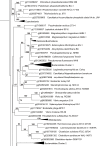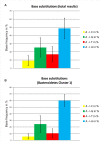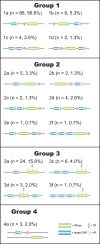Analysis of a comprehensive dataset of diversity generating retroelements generated by the program DiGReF
- PMID: 22928525
- PMCID: PMC3521204
- DOI: 10.1186/1471-2164-13-430
Analysis of a comprehensive dataset of diversity generating retroelements generated by the program DiGReF
Abstract
Background: Diversity Generating Retroelements (DGRs) are genetic cassettes that can introduce tremendous diversity into a short, defined region of the genome. They achieve hypermutation through replacement of the variable region with a strongly mutated cDNA copy generated by the element-encoded reverse transcriptase. In contrast to "selfish" retroelements such as group II introns and retrotransposons, DGRs impart an advantage to their host by increasing its adaptive potential. DGRs were discovered in a bacteriophage, but since then additional examples have been identified in some bacterial genomes.
Results: Here we present the program DiGReF that allowed us to comprehensively screen available databases for DGRs. We identified 155 DGRs which are found in all major classes of bacteria, though exhibiting sporadic distribution across species. Phylogenetic analysis and sequence comparison showed that DGRs move between genomes by associating with various mobile elements such as phages, transposons and plasmids. The DGR cassettes exhibit high flexibility in the arrangement of their components and easily acquire additional paralogous target genes. Surprisingly, the genomic data alone provide new insights into the molecular mechanism of DGRs. Most notably, our data suggest that the template RNA is transcribed separately from the rest of the element.
Conclusions: DiGReF is a valuable tool to detect DGRs in genome data. Its output allows comprehensive analysis of various aspects of DGR biology, thus deepening our understanding of the role DGRs play in prokaryotic genome plasticity, from the global down to the molecular level.
Figures







References
Publication types
MeSH terms
Substances
LinkOut - more resources
Full Text Sources
Molecular Biology Databases

